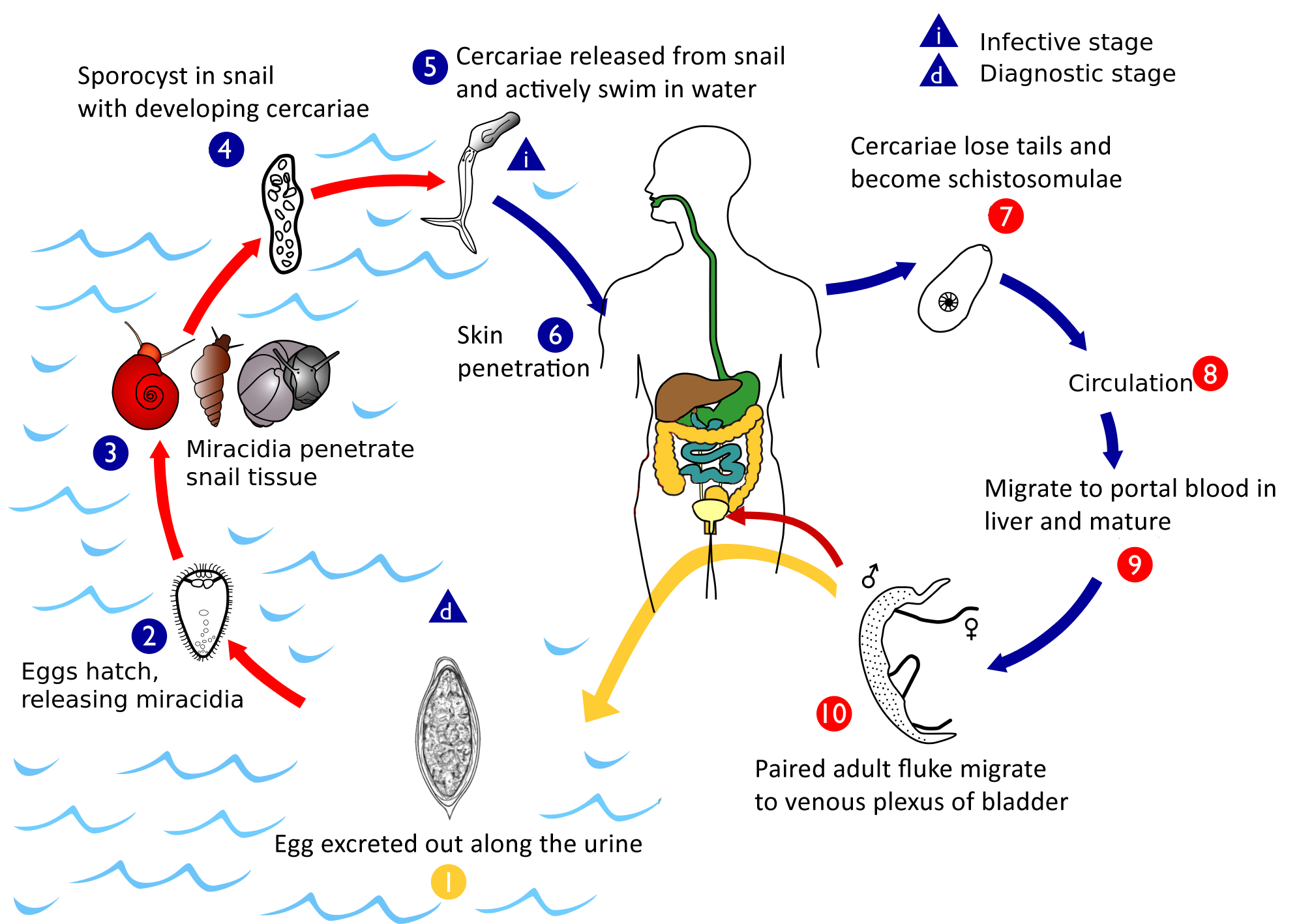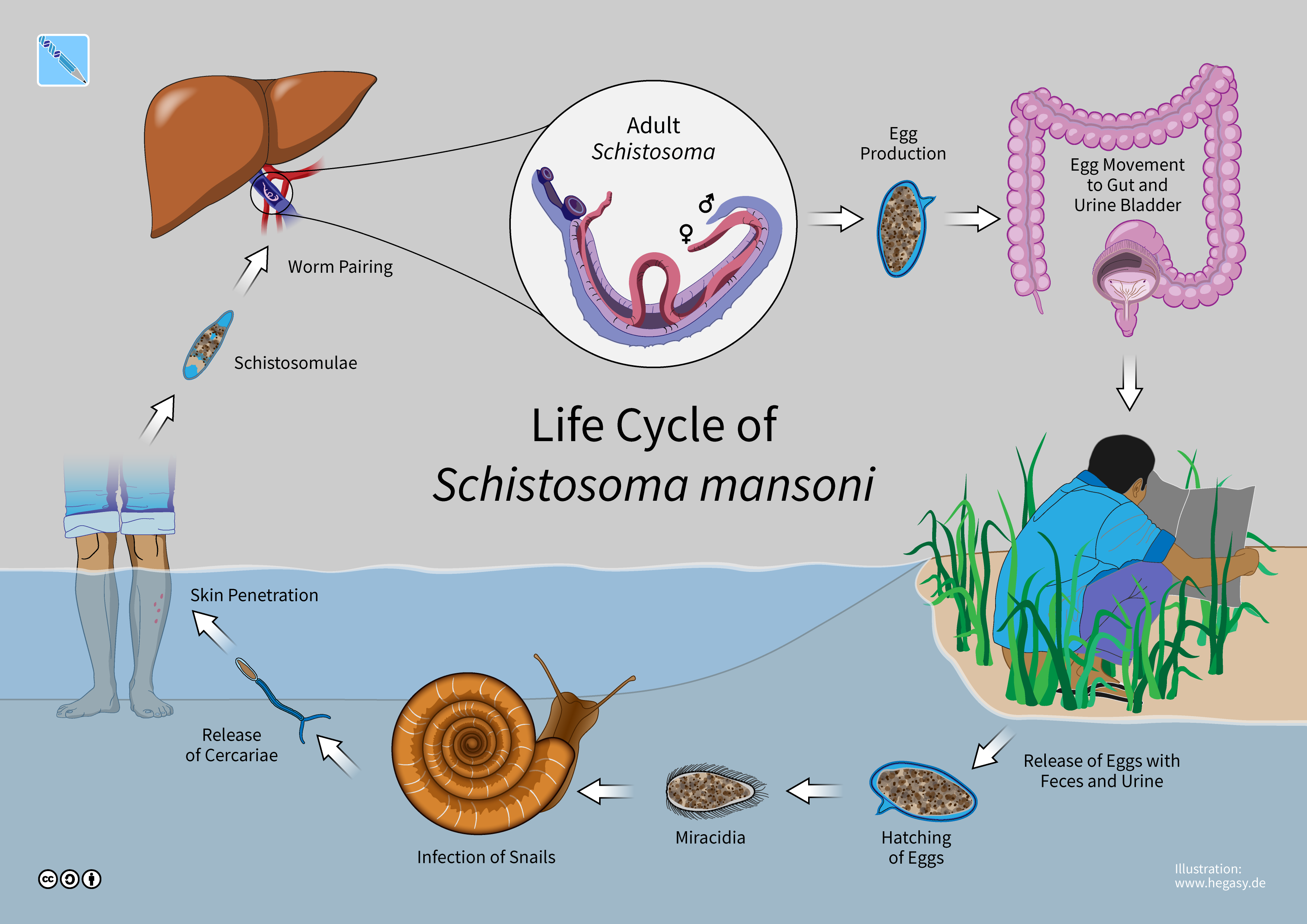|
Bilharzial Cor Pulmonale
Bilharzial cor pulmonale is the condition of right sided heart failure secondary to fibrosis and sclerosis of the pulmonary artery branches. It results from shifting of the ''Schistosoma haematobium'' ova from the pelvic and vesical plexus to the pulmonary artery branches where they settle and produce granuloma and fibrosis. Bilharzial cor pulmonale occurs in ''Schistosoma mansoni'', when the portal pressure rises more than the systemic pressure. So blood will pass from the portal circulation to the systemic circulation carrying ''Schistosoma mansoni'' ova to reach the lungs. This condition leads to pulmonary hypertension, right ventricular hypertrophy and failure. Retrieved 26 December 2016
|
Cardiology
Cardiology () is a branch of medicine that deals with disorders of the heart and the cardiovascular system. The field includes medical diagnosis and treatment of congenital heart defects, coronary artery disease, heart failure, valvular heart disease and electrophysiology. Physicians who specialize in this field of medicine are called cardiologists, a specialty of internal medicine. Pediatric cardiologists are pediatricians who specialize in cardiology. Physicians who specialize in cardiac surgery are called cardiothoracic surgeons or cardiac surgeons, a specialty of general surgery. Specializations All cardiologists study the disorders of the heart, but the study of adult and child heart disorders each require different training pathways. Therefore, an adult cardiologist (often simply called "cardiologist") is inadequately trained to take care of children, and pediatric cardiologists are not trained to treat adult heart disease. Surgical aspects are not included in cardiology ... [...More Info...] [...Related Items...] OR: [Wikipedia] [Google] [Baidu] |
Parasitology
Parasitology is the study of parasites, their hosts, and the relationship between them. As a biological discipline, the scope of parasitology is not determined by the organism or environment in question but by their way of life. This means it forms a synthesis of other disciplines, and draws on techniques from fields such as cell biology, bioinformatics, biochemistry, molecular biology, immunology, genetics, evolution and ecology. Fields The study of these diverse organisms means that the subject is often broken up into simpler, more focused units, which use common techniques, even if they are not studying the same organisms or diseases. Much research in parasitology falls somewhere between two or more of these definitions. In general, the study of prokaryotes falls under the field of bacteriology rather than parasitology. Medical The parasitologist F.E.G. Cox noted that "Humans are hosts to nearly 300 species of parasitic worms and over 70 species of protozoa, some derived f ... [...More Info...] [...Related Items...] OR: [Wikipedia] [Google] [Baidu] |
Heart Failure
Heart failure (HF), also known as congestive heart failure (CHF), is a syndrome, a group of signs and symptoms caused by an impairment of the heart's blood pumping function. Symptoms typically include shortness of breath, excessive fatigue, and leg swelling. The shortness of breath may occur with exertion or while lying down, and may wake people up during the night. Chest pain, including angina, is not usually caused by heart failure, but may occur if the heart failure was caused by a heart attack. The severity of the heart failure is measured by the severity of symptoms during exercise. Other conditions that may have symptoms similar to heart failure include obesity, kidney failure, liver disease, anemia, and thyroid disease. Common causes of heart failure include coronary artery disease, heart attack, high blood pressure, atrial fibrillation, valvular heart disease, excessive alcohol consumption, infection, and cardiomyopathy. These cause heart failure by altering ... [...More Info...] [...Related Items...] OR: [Wikipedia] [Google] [Baidu] |
Fibrosis
Fibrosis, also known as fibrotic scarring, is a pathological wound healing in which connective tissue replaces normal parenchymal tissue to the extent that it goes unchecked, leading to considerable tissue remodelling and the formation of permanent scar tissue. Repeated injuries, chronic inflammation and repair are susceptible to fibrosis where an accidental excessive accumulation of extracellular matrix components, such as the collagen is produced by fibroblasts, leading to the formation of a permanent fibrotic scar. In response to injury, this is called scarring, and if fibrosis arises from a single cell line, this is called a fibroma. Physiologically, fibrosis acts to deposit connective tissue, which can interfere with or totally inhibit the normal architecture and function of the underlying organ or tissue. Fibrosis can be used to describe the pathological state of excess deposition of fibrous tissue, as well as the process of connective tissue deposition in healing. Define ... [...More Info...] [...Related Items...] OR: [Wikipedia] [Google] [Baidu] |
Sclerosis (medicine)
Sclerosis (from Greek σκληρός ''sklērós'', "hard") is the stiffening of a tissue or anatomical feature, usually caused by a replacement of the normal organ-specific tissue with connective tissue. The structure may be said to have undergone sclerotic changes or display sclerotic lesions, which refers to the process of sclerosis. Common medical conditions whose pathology involves sclerosis include: * Amyotrophic lateral sclerosis—also known as Lou Gehrig's disease or motor neurone disease—a progressive, incurable, usually fatal disease of motor neurons. * Atherosclerosis, a deposit of fatty materials, such as cholesterol, in the arteries which causes hardening. * Focal segmental glomerulosclerosis is a disease that attacks the kidney's filtering system (glomeruli) causing serious scarring and thus a cause of nephrotic syndrome in children and adolescents, as well as an important cause of kidney failure in adults. * Hippocampal sclerosis, a brain damage often seen in ... [...More Info...] [...Related Items...] OR: [Wikipedia] [Google] [Baidu] |
Pulmonary Artery
A pulmonary artery is an artery in the pulmonary circulation that carries deoxygenated blood from the right side of the heart to the lungs. The largest pulmonary artery is the ''main pulmonary artery'' or ''pulmonary trunk'' from the heart, and the smallest ones are the arterioles, which lead to the capillaries that surround the pulmonary alveoli. Structure The pulmonary arteries are blood vessels that carry systemic venous blood from the right ventricle of the heart to the microcirculation of the lungs. Unlike in other organs where arteries supply oxygenated blood, the blood carried by the pulmonary arteries is deoxygenated, as it is venous blood returning to the heart. The main pulmonary arteries emerge from the right side of the heart, and then split into smaller arteries that progressively divide and become arterioles, eventually narrowing into the capillary microcirculation of the lungs where gas exchange occurs. Pulmonary trunk In order of blood flow, the pulmonary art ... [...More Info...] [...Related Items...] OR: [Wikipedia] [Google] [Baidu] |
Schistosoma Haematobium
''Schistosoma haematobium'' (urinary blood fluke) is a species of digenetic trematode, belonging to a group (genus) of blood flukes (''Schistosoma''). It is found in Africa and the Middle East. It is the major agent of schistosomiasis, the most prevalent parasitic infection in humans. It is the only blood fluke that infects the urinary tract, causing urinary schistosomiasis, and is the leading cause of bladder cancer (only next to tobacco smoking). The diseases are caused by the eggs. Adults are found in the venous plexuses around the urinary bladder and the released eggs travels to the wall of the urine bladder causing haematuria and fibrosis of the bladder. The bladder becomes calcified, and there is increased pressure on ureters and kidneys otherwise known as hydronephrosis. Inflammation of the genitals due to ''S. haematobium'' may contribute to the propagation of HIV. ''S. haematobium'' was the first blood fluke discovered. Theodor Bilharz, a German surgeon working in Cair ... [...More Info...] [...Related Items...] OR: [Wikipedia] [Google] [Baidu] |
Vesical Venous Plexus
The vesical plexus envelops the lower part of the bladder and the base of the prostate and communicates with the pudendal and prostatic plexuses. It is drained, by means of several vesical veins The vesical veins are veins in the pelvis that drain blood from the urinary bladder. The vesical veins receive blood from the vesical venous plexus The vesical plexus envelops the lower part of the bladder and the base of the prostate The ..., into the internal iliac veins. References External links Anatomy at umich.edu Veins of the torso {{circulatory-stub ... [...More Info...] [...Related Items...] OR: [Wikipedia] [Google] [Baidu] |
Granuloma
A granuloma is an aggregation of macrophages that forms in response to chronic inflammation. This occurs when the immune system attempts to isolate foreign substances that it is otherwise unable to eliminate. Such substances include infectious organisms including bacteria and fungi, as well as other materials such as foreign objects, keratin, and suture fragments. Definition In pathology, a granuloma is an organized collection of macrophages. In medical practice, doctors occasionally use the term ''granuloma'' in its more literal meaning: "a small nodule". Since a small nodule can represent any tissue from a harmless nevus to a malignant tumor, this use of the term is not very specific. Examples of this use of the term ''granuloma'' are the lesions known as vocal cord granuloma (known as contact granuloma), pyogenic granuloma, and intubation granuloma, all of which are examples of granulation tissue, not granulomas. "Pulmonary hyalinizing granuloma" is a lesion characterized ... [...More Info...] [...Related Items...] OR: [Wikipedia] [Google] [Baidu] |
Schistosoma Mansoni
A paired couple of ''Schistosoma mansoni''. ''Schistosoma mansoni'' is a water-borne parasite of humans, and belongs to the group of blood flukes (''Schistosoma''). The adult lives in the blood vessels ( mesenteric veins) near the human intestine. It causes intestinal schistosomiasis (similar to '' S. japonicum'', '' S. mekongi'', ''S. guineensis'', and '' S. intercalatum''). Clinical symptoms are caused by the eggs. As the leading cause of schistosomiasis in the world, it is the most prevalent parasite in humans. It is classified as a neglected tropical disease. As of 2021, the World Health Organization reports that 236.6 million people have schistosomiasis and most of it is due to ''S. mansoni''. It is found in Africa, the Middle East, the Caribbean, Brazil, Venezuela and Suriname. Unlike other flukes (trematodes) in which sexes are not separate ( monoecious), schistosomes are unique in that adults are divided into males and females, thus, gonochoric. However, a permanent ... [...More Info...] [...Related Items...] OR: [Wikipedia] [Google] [Baidu] |
Portal Venous Pressure
Portal venous pressure is the blood pressure in the hepatic portal vein, and is normally between 5-10 mmHg. Raised portal venous pressure is termed portal hypertension, and has numerous sequelae such as ascites and hepatic encephalopathy. Wedged hepatic venous pressure (WHVP) WHVP is used to estimate the portal venous pressure by reflecting not the actual hepatic portal vein pressure but the hepatic sinusoidal pressure. It is determined by wedging a catheter in a hepatic vein, to occlude it, and then measuring the pressure of proximal static blood (which is reflective of pressure in the sinusoids). WHVP in fact slightly underestimates portal pressure due to sinusoidal equilibration in patients without cirrhosis Cirrhosis, also known as liver cirrhosis or hepatic cirrhosis, and end-stage liver disease, is the impaired liver function caused by the formation of scar tissue known as fibrosis due to damage caused by liver disease. Damage causes tissue repai ..., but the difference bet ... [...More Info...] [...Related Items...] OR: [Wikipedia] [Google] [Baidu] |
Lung
The lungs are the primary organs of the respiratory system in humans and most other animals, including some snails and a small number of fish. In mammals and most other vertebrates, two lungs are located near the backbone on either side of the heart. Their function in the respiratory system is to extract oxygen from the air and transfer it into the bloodstream, and to release carbon dioxide from the bloodstream into the atmosphere, in a process of gas exchange. Respiration is driven by different muscular systems in different species. Mammals, reptiles and birds use their different muscles to support and foster breathing. In earlier tetrapods, air was driven into the lungs by the pharyngeal muscles via buccal pumping, a mechanism still seen in amphibians. In humans, the main muscle of respiration that drives breathing is the diaphragm. The lungs also provide airflow that makes vocal sounds including human speech possible. Humans have two lungs, one on the left and on ... [...More Info...] [...Related Items...] OR: [Wikipedia] [Google] [Baidu] |







